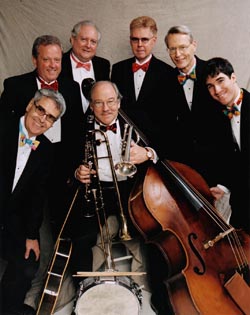
The Jim Cullum Jazz Band. Photo courtesy bakersfieldcca.org
On this broadcast, we celebrate the 40th Anniversary of The Jim Cullum Jazz Band—that’s 40 years of jazz at The Landing jazz club on the winding Paseo del Rio pathway along the river in downtown San Antonio, Texas. Through the years jazz lovers from around the world have made the pilgrimage to The Landing to hear what bandleader Jim Cullum calls “the real stuff”—hot jazz of the 1920s and 30s.
Here’s how it all started:
In the 1940s Jim Cullum Sr. worked in the family wholesale grocery business in Dallas; he was also a successful jazz clarinet player, performing in bands led by Jack Teagarden and Jimmy Dorsey. Jim Sr. had a business opportunity come his way in 1953, and though it meant leaving Dallas and settling in San Antonio, he decided to make the move with his young family including twelve-year-old Jim Jr. The change of hometown had long-lasting consequences for him. Jim Jr. says, “Missing my pals in Dallas, I began to listen to my father’s records to pass the time. He’d packed away his collection of 78-rpm jazz records in a wooden chest when he left Dallas. Pretty soon I discovered those Louis Armstrong records made me feel real good. Soon after, I found his Bix [Beiderbecke] records, so before I played an instrument at all, these guys had become my heroes.
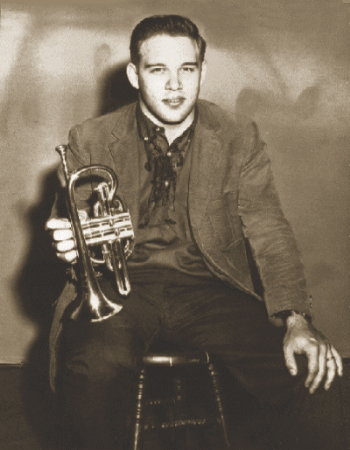
Jim Cullum at age 18. Photo courtesy of the artist.
“I listened to my father’s record collection day and night up in my room with the door closed. Without really thinking about it, pretty soon I knew many of them by heart. Those riffs and melodies were always in my mind and I started to whistle them. One day, my father and I were riding in the car and I was whistling this Bix solo to myself, sort of absentmindedly. My father listened for a bit and said, ‘Hey, that’s pretty good music. Maybe you should take up a trombone or something.’
A nearby Pawn Shop had an interesting horn in the window. “I thought to myself maybe that was the kind of cornet Bix Beiderbecke played! I went over to see about the cornet and the guy behind the counter told me it was going for twelve dollars. I went back again a couple more times. Finally I got him to sell it to me for seven dollars. I went on over to the San Antonio Music Company and bought a book on “How to Play the Cornet” for a dollar. For an eight-dollar investment I had a career.”
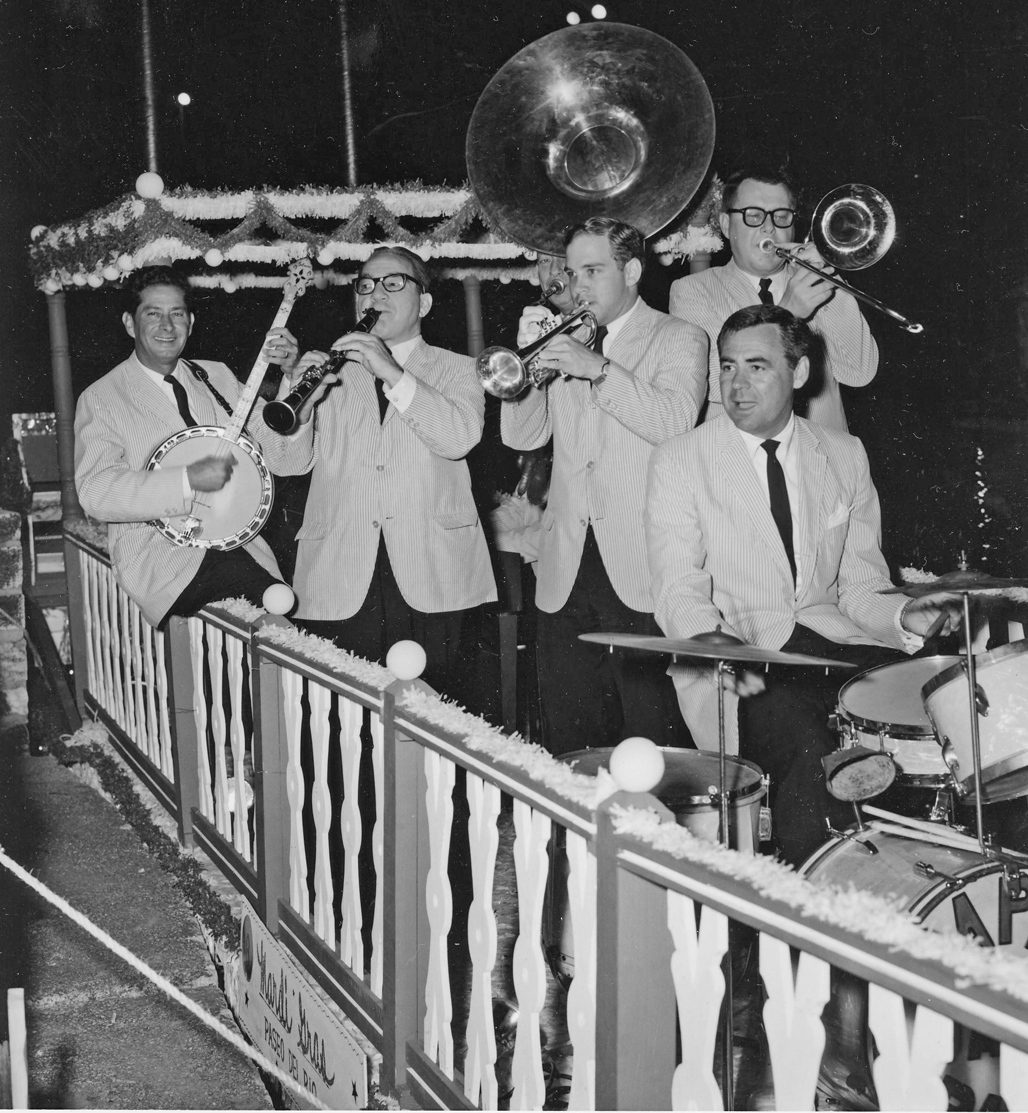
Jim Cullum Sr. and Jr. with The Happy Jazz Band on the San Antonio River. Photo courtesy of Jim Cullum Jr.
While in college, Jim Jr. and his father formed a band with local musicians and called it the “Happy Jazz Band.” Jim Sr. wanted the name to reflect a positive attitude, full of joy and life—like the Louis Armstrong music he admired so much. From the start, the Happy Jazz Band made at least one recording a year. Later, when the Cullums acquired the Audiophile record label, recordings of the band and other jazz groups poured out. One of the best is a 1967 album called Goose Pimples, made with cornet giant Bobby Hackett, a veteran of the Benny Goodman and Glenn Miller orchestras and a former staff musician at NBC. Jim Cullum Jr. says, “[Hackett] is one of my idols. To this day, I revere his music. It was a thrill to record and perform with him. My father and I got to be good friends with Bobby Hackett.”
Series co-host David Holt talks with bandleader Jim Cullum Jr. about his many musical influences, and Jim says his greatest inspiration has come from the members of The Jim Cullum Jazz Band. “Some of the guys on this stage like [pianist] John Sheridan and [banjo/guitarist] Howard Elkins have been with the band for over 20 years. Along the way, there have been a lot of excellent players. My early attitudes and ideas about the music came from my father who showed me the way on a lot of these things. I had the benefit of his years of listening to the music. He had a beautiful tone and a lot of heart in his playing. Like his friend and hero Irving Fazola, my father had the ability to take a very simple melody and embellish it, make something of it.
.jpg)
Howard Elkins. Photo courtesy of the artist.
.jpg)
John Sheridan. Photo courtesy of the artist.
The addition of guitarist Howard Elkins and pianist/arranger John Sheridan in 1979 gave the band a creative boost. John began to write new music arrangements, expanding the Band's music library to over a thousand charts. Among the most significant pieces is the first-ever arrangement for 7-piece jazz band of “Freakish,” a Jelly Roll Morton solo piano piece.
Throughout the 40-year history of The Jim Cullum Jazz Band, the Cullums (father and son) enjoyed close relationships with leading figures in classic jazz. Trumpeter Yank Lawson and composer/bassist Bob Haggart were key members of the Bob Crosby Bobcats and founding members of The World’s Greatest Jazz Band. Both were good friends and colleagues of the Cullums. On this broadcast, Jim Cullum recalls his father asking the two jazzmen to come to San Antonio for a ‘Battle of the Bands’ concert. Jim says, “His rationale was, ‘You guys can’t call yourselves the World’s Greatest without a fight!’ So they came twice and we had terrific concerts with them.”
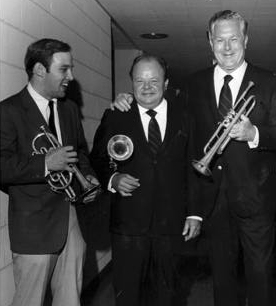
Jim Cullum, Jr., Billy Butterfield and trumpeter Yank Lawson, cir. 1968. Photo courtesy Jim Cullum Jr.
The Jim Cullum Jazz Band and its predecessor The Happy Jazz Band have had a long history in radio broadcasting. Early on, Jim and his father maintained a presence on local AM stations. They began broadcasting on a small local station, KITE, the first year The Landing was a going concern. Jim says, “Then we were picked up by WOAI, a powerful 50,000 watt clear channel station. You could hear it all over the country, particularly late at night in the Midwest all the way up to Canada, and down into Mexico. We were on WOAI for five years and broadcast all the shows live with just two microphones. For some of them, we had no engineer. It was really a kick to do those early shows. One time we got a post card from Bing Crosby who heard our radio show on a boat in Acapulco Bay.”
Broadcast Playlist Music Notes:
Jim Cullum’s Dallas cousin, the cornetist Garner Clark, composed “Westmoreland Weave.” The tune is a “riff” on the chord changes of “When My Dreamboat Comes Home.”
“Ostrich Walk” is a Bix Beiderbecke recording Jim Cullum Sr. had in his record collection which Jim Jr. memorized by whistling Bix’ solos.
“Chlo-e” from 1927 is a show tune by Charles N. Daniels, writing under the pseudonym Neil Morét. It bears the subtitle “Song of the Swamp” and is on the Goose Pimples LP.
“Zacatecas March” dates from the days of the Mexican Revolution. Jim Cullum says, “In the early days in San Antonio, most of the musicians knew that march, the Mexican border is only 150 miles away. Many of the popular Mexican standards were marches like this one, and it makes a great jazz tune.”
“Almost Daylight” is the result of a collaboration between Jim Cullum and his musical hero, Australian cornet master Bob Barnard.
“Gypsy Love Song” is a staple of The Jim Cullum Jazz Band playbook. It was written in 1898 by Victor Herbert for the operetta The Fortune Teller and entered the jazz world through a hot version by the Bob Crosby Bob Cats in the 1930s.
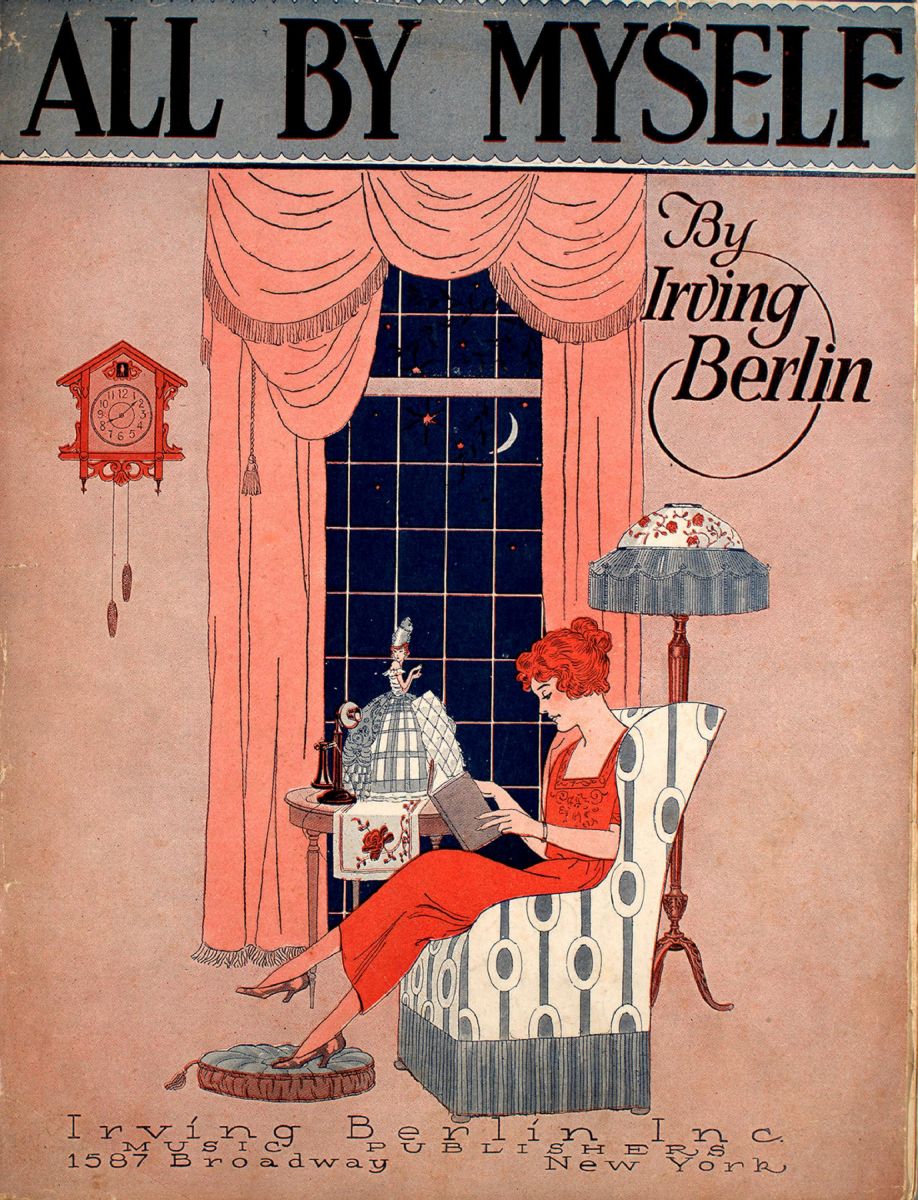
"All By Myself" vintage sheet music. Image in public domain.
“Blue Prelude” was composed by Gordon Jenkins in 1933 and introduced by the Isham Jones Orchestra. Saxophonist Adrian Rollini covered it that same year. This number has been a standard in the repertoire of both the Happy Jazz Band and The Jim Cullum Jazz Band.
“All By Myself” is an Irving Berlin number dating from a 1921 musical revue. Many songs have been composed with this title, but Berlin’s is among the earliest and most successful; the sheet music sold over 1 million copies, a huge success for the time. Crooner Bing Crosby performed Berlin’s “All By Myself” in the 1946 film Blue Skies. Later, Bing’s brother Bob Crosby would record a hot jazz arrangement with his Bob Cats. It is the Bob Cats’ rendition, which inspires The Jim Cullum Jazz Band interpretation on our radio show.
Photo credit for Home Page: The Jim Cullum Jazz Band photo courtesy bakersfieldcca.org.
Text based on Riverwalk Jazz script by Margaret Moos Pick ©2002

